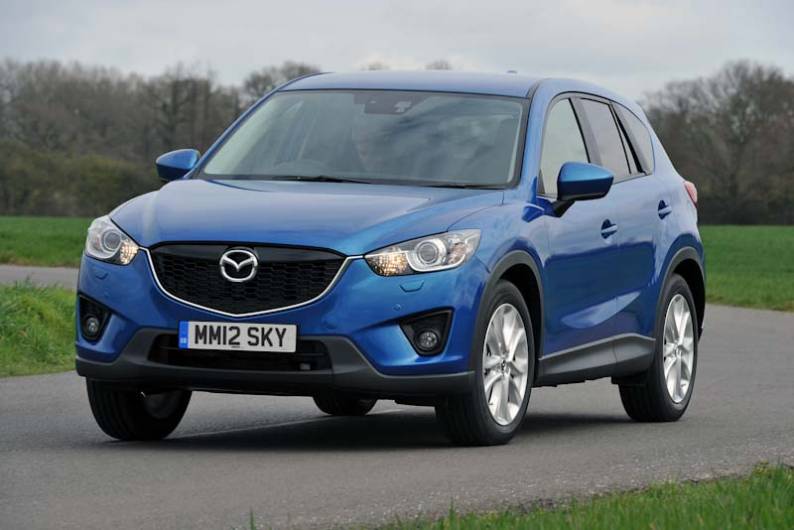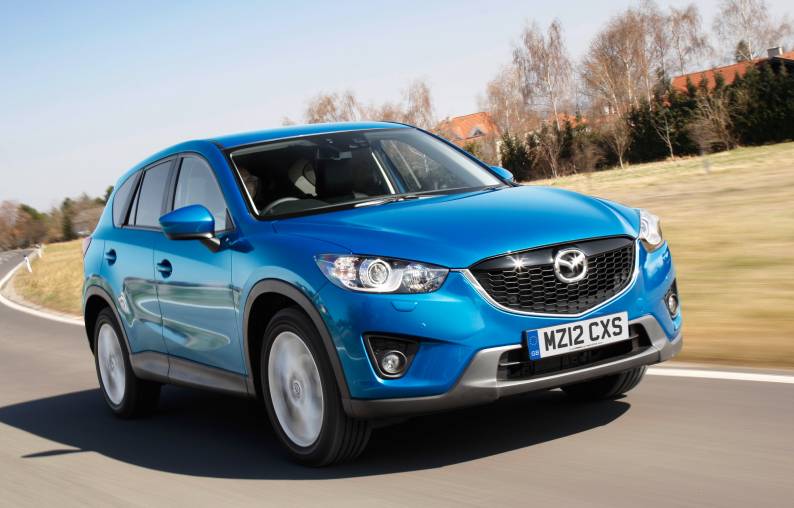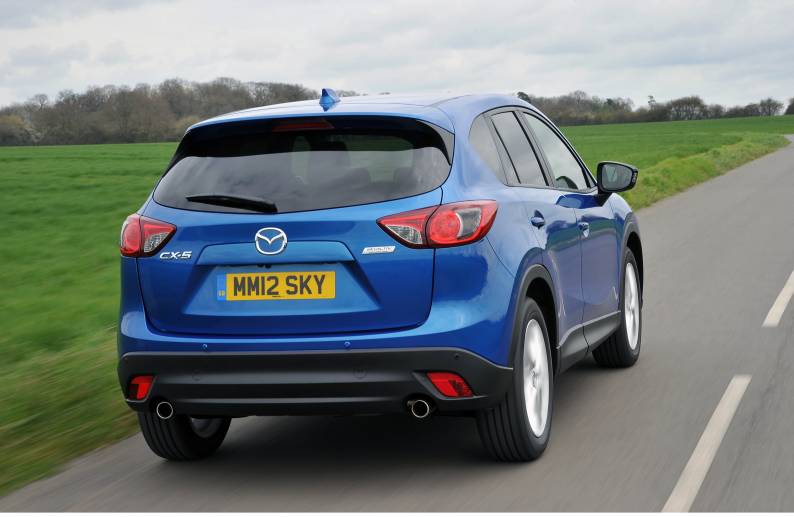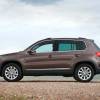
RAC sale – up to 33% off*
• Roadside cover from £5.29 a month†
• We get to most breakdowns in 60 mins or less
• Our patrols fix 4/5 breakdowns on the spot

Things you'll like
- Comfortable and good to drive
- Efficient engine range
- Facelift greatly improved the cabin
Things to consider
- Some rivals are quieter at speed
- Reported diesel reliability concerns
- Early interiors are drab
History: What is the 2012-2017 Mazda CX-5?
Mazda has built a loyal global following as a car company pushing innovation. From its ‘Wankel’ rotary engine options to the clever Skyactiv-X ignition tech, the storied Japanese car maker has a reputation for doing things differently.
Perhaps that explains why Mazda was so late to the European crossover SUV craze. Oh sure, it had models such as the slow-selling Tribute (a rebadged US-market Ford Escape) and the larger CX-7, but these were clearly targeted at markets outside of Europe and made little impact here.
It wasn’t until the CX-5 that Mazda really took the segment seriously. With competitors such as the Nissan Qashqai, Volkswagen Tiguan and Ford Kuga already making waves, the CX-5’s arrival in 2012 was a few years late – but better late than never.
The CX-5 was the first car to debut Mazda’s ‘Kodo: Soul of Motion’ design philosophy, as well as fuel-efficient Skyactiv engine tech. That might sound like marketing jargon, but the sharp-suited SUV certainly captured the attention of buyers, quickly becoming Mazda’s global best-seller – a title it’s retained until today.
With nearly four million CX-5s on the road around the world, it’s a popular model. But ‘popular’ doesn’t always mean ‘good’. Does the first-generation CX-5 cut the mustard as a used car purchase? We delve deeper in this review to find out.
Verdict: is the Mazda CX-5 a good car?
Anyone looking for a capable, good to drive all-round family SUV should take a close look at the 2012-2017 Mazda CX-5. It’s a solid option that’s well-priced, and the interior upgrades for 2015 added a real air of class. Petrol engines are proving reliable, too, but be aware of reported issues with the diesels before buying.
Specs and used pricing
The CX-5 was originally launched with two trim levels: SE L and Sport. Both also came with ‘Nav’ version which include sat-nav (unsurprisingly).
Even SE L versions are well equipped with kit such as 17-inch alloys, cruise control, dual-zone climate control, front and rear parking sensors, a 5.8-inch touchscreen, Bluetooth, auto wipers and automatic city emergency braking.
Upgrading to Sport trim raises the wheel size to 19 inches, while also adding bi-xenon headlights, leather upholstery, electric adjustment for the driver’s seat, a nine-speaker Bose sound system and a reversing camera.
-scr.jpg)
In 2014, the CX-5 benefitted from some suspension upgrades improving comfort and refinement, while the year after that brought a mild facelift that mainly focused on interior tweaks, equipment upgrades and improved technology.
These models offer features like optional adaptive LED headlamps and a larger seven-inch central display with a rotary controller, while a new SE-L Lux trim bridges the gap between SE-L and Sport, adding kit such as leather and a sunroof.
In terms of used pricing, it pays to shop wisely. While the glut of sub-£3,000 high mileage diesel CX-5s you can find for sale seem tempting, they’ll likely be overdue mechanical attention or suffering from some of this engine’s known serious issues.
It’s better to start your budget at £4,000, where you’ll find both diesel and petrol SE-L Nav models with around 100-120,000 miles on the clock. Given the issues with the diesel can stem from being driven short distances, we’d be more put off by low mileage examples at this price point.
Around £5,000 gets you in a better condition model or a post-2014 car with the suspension updates, while £6,000 gets you into the facelifted version. £7-8,000 is all you’ll need for the best and newest examples of this generation of CX-5.
Rivals
There were no shortage of alternatives to the Mazda CX-5 by the time it arrived in 2012. By that time cars like the Honda CR-V, Toyota RAV4, Nissan Qashqai, Volkswagen Tiguan and Ford Kuga were already well established, for example.
While those are all strong options, other alternatives to consider include the Peugeot 3008, Kia Sportage, Hyundai IX35/Tucson, Skoda Yeti and premium brand alternatives such as the Volvo XC60 and Lexus NX.
Interior and practicality
It’s a tale of two cabins with the Mazda CX-5. Pre-2015 versions featured a functional but rather drab interior, majoring on easy operation rather than upmarket details.
It’s fine, and about at the same level as the Nissan Qashqai or Ford Kuga quality-wise, but we’d really recommend seeking out a 2015-on example. This brought a noticeable boost in finish, with more metal-effect detailing and plusher finishes along with an improved dash design.
The technology overhaul was significant in 2015, too. Early cars got a touchscreen-only 5.8-inch infotainment system that wasn’t especially easy to use (despite physical shortcut buttons).
For 2015, the touchscreen element was ditched, but in its place came a BMW iDrive-style rotary dial controller mounted on the centre console. Along with a larger seven-inch screen and much improved menus and graphics, it made for a far better user experience than the old system.
These changes really helped the CX-5 bridge the gap between cheaper mainstream SUVs and the more expensive premium competition. But if none of that bothers you, the early car’s cabin is at least full of easy-to-use physical controls.
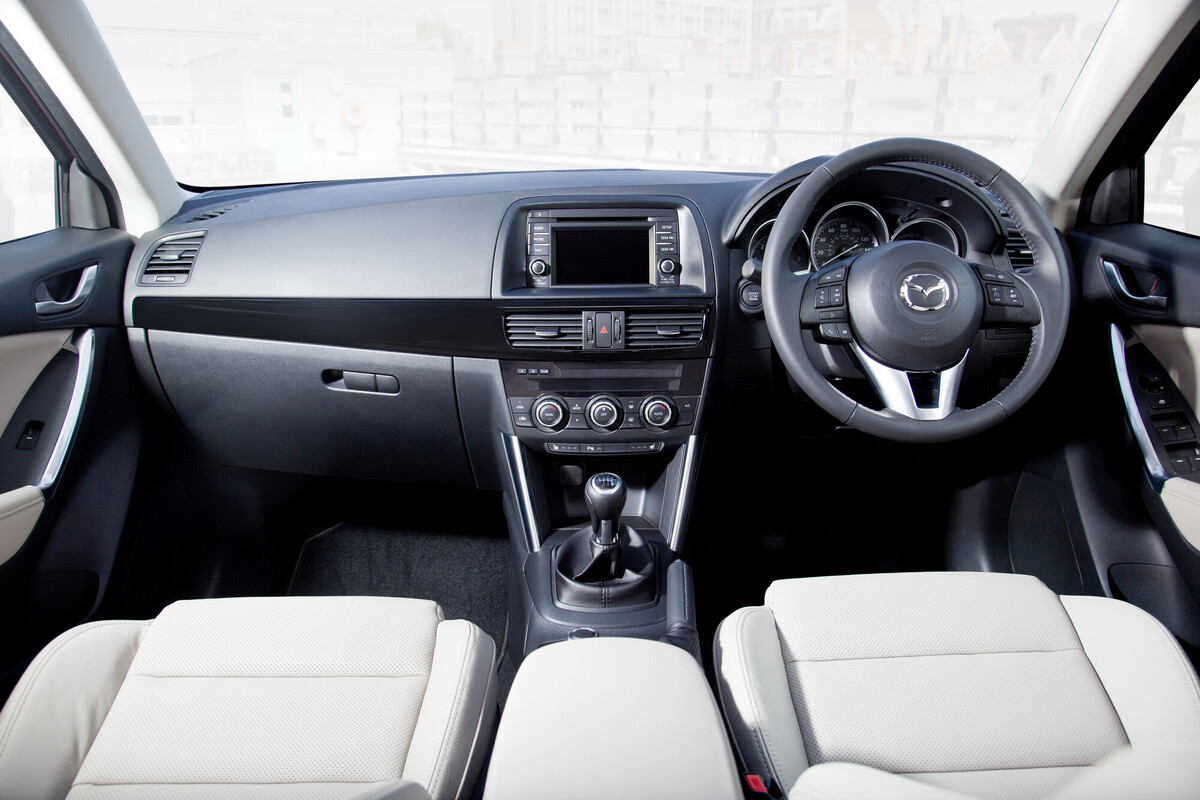
Passenger space, storage and boot space
The CX-5 is a spacious and practical option for families or those that regularly carry passengers. It’s roomier than the Qashqai of the time, as you’d expect given its larger external size.
Adults can travel comfortably in the back, with good levels of head and legroom throughout – only the Honda CR-V is noticeably roomier. You also get just enough cabin width to sit three across the back in moderate comfort, plus a good level of storage throughout.
The boot, too, is a good size at 503 litres in capacity. That’s larger than a Ford Kuga or the Qashqai, but again behind the spacious CR-V. We like the Mazda’s standard 40/20/40 split-folding rear seats, as well as the easy operation of the boot-mounted folding levers.
What is a used Mazda CX-5 like to drive?
By the time the CX-5 came along Mazda had quietly built a reputation for making ‘normal’ cars that captured a bit of the spirit of the brilliant MX-5 sports car on the road. The excellent Mazda 3 and 6 were good examples of this.
The CX-5’s purposeful driving position hints at that sporting inspiration, as does the well-weighted clutch and slick manual gearbox. And indeed, it was one of the most confidence-inspiring SUVs on sale at the time when it came to handling thanks to precise, feelsome steering and well-tuned suspension. This was improved even further with some suspension updates in 2014.
Don’t go expecting fireworks, though – this is still a comfort-focused car which will wallow about if pushed in the bends. A Ford Kuga is slightly keener to change direction, but the Mazda balances that with a smoother ride that soaks up low-speed bumps while remaining impressively controlled on the motorway. The only black mark is the CX-5, particularly the pre-2014 version, is a little noisier at speed than rivals.
Despite the all-wheel drive option, the CX-5 is very much a road-biased SUV. There’s no switchable off-road modes or hill descent control to help navigate rugged terrain – something like a Jeep Renegade is much more at home there. However, the Mazda will deal with rutted tracks and muddy car parks as well as most owners would need it to.
Engines
The CX-5’s engine range wasn’t exactly extensive. There was only a pair of four-cylinder units: a 2.0-litre petrol engine and a 2.2-litre diesel in two states of tune.
The petrol engine was naturally aspirated at a time when turbocharging was becoming the norm for improved efficiency. But Mazda had a trick up its sleeve with its ‘Skyactiv Technology’ – a term for the intense lightweighting approach taken with the CX-5.
The result was a car that weighs a touch over 1400kg in its lightest form: for reference, a Land Rover Freelander was more like 1700kg.
Combined with a cleverly tuned high compression petrol engine putting out a stout 165hp (despite the lack of a turbo) it meant a respectable 0-62mph time of 9.2 seconds combined with decent fuel economy. It needed revving out to get meaningful acceleration, but that wasn’t an unpleasant task.
Really, though, the 2.2-litre diesels were the engines of choice in the CX-5 – and customers agreed. Most examples feature the 150hp variant, which was front-wheel-drive only and, in six-speed manual form, managed the same 9.2-second 0-62mph time as the petrol.
In real-world driving, though, its 380Nm of torque made for much swifter in-gear progress than the petrol. It’s smooth, refined and quite keen to rev by the standards of diesel engines of the day, and would be our choice – but there are some important reliability reports to consider (below).
The 175hp version was only mated to a four-wheel drive system and is most commonly found with a six-speed automatic transmission. Although it has 40Nm more torque than the lower-powered unit, in real-world driving it doesn’t feel massively quicker than the cheaper 150hp version.
However, if all-wheel drive is a must, or you need maximum torque for towing caravans or the like, the more powerful 2.2 is still a strong buy.
.jpg)
Ownership, running costs and reliability
Mazda’s Skyactiv engines were primarily designed to reduce CO2 emissions – a key component of company car selection at the time due to the tax rules. That has a knock-on effect with fuel economy, however.
The petrol CX-5 impresses given its size, relatively high power output and lack of turbocharging. An official figure of 47.1mpg compares well with heavier and considerably thirstier petrol SUVs of the time.
In fact, that figure isn’t far off the 2.2 diesel in 175hp all-wheel drive automatic form, which officially manages 51.4mpg. Both the auto ‘box and the all-wheel drive system put a considerable dent in fuel economy – the front-wheel drive, manual model promises 61.4mpg.
It’s worth considering whether you really need four driven wheels and an automatic – and not just for fuel economy, because that higher powered diesel auto costs £215 a year in car tax (VED) due to its high emissions. Meanwhile, the base diesel manual is just £35 a year, while the petrol is £195 a year.
Diesels were improved for efficiency over time, and 2015-on examples in particular deliver the kind of fuel economy you’d hope for from an advanced, lightweight unit. However, there is a couple of key issues the 2.2d can suffer from that it pays to be aware of.
The first is a common modern diesel issue: cars that have mainly been driven on short journeys suffer from a clogged Diesel Particulate Filter (DPF) causing the engine oil to become diluted with fuel – something which can have serious consequences.
The easiest way to spot this is to check your oil dipstick for signs of the oil level rising and the smell of fuel in your oil. It’s also essential to let the car complete its regeneration cycle which cleans the
Another reported issue is with leaking injector seals that let unburnt fuel through into the engine causing carbon build-up. Eventually, this blocks the oil pickup, causing oil starvation and the engine seizing. Mazda recommends new injector seals as part of the 75,000-mile service – so ensure this is done and consider getting it done earlier as a preventative measure.
The CX-5’s petrol engine, on the other hand, seems to be proving relatively dependable. Beyond some carbon buildup on high mileage engines (typical of direct injection petrols) there’s little to report – so those looking for trouble-free motoring should consider the petrol option.
We'd also add the usual caveats: a full service history is highly desirable unless it's cheap enough to take the gamble (it's not a gamble we'd take with the diesel), while checking the condition of the brake pads and discs and ensuring the battery is healthy can help avoid unwanted bills soon after purchasing.
Euro NCAP: is a used Mazda CX-5 a safe car?
With such tough competition in the SUV market, the CX-5 had to deliver on all fronts. And as far as family-friendly safety is concerned it hit the desired standard with a maximum five-star crash test rating from Euro NCAP.
With an impressive 94% adult occupant rating, 87% for child protection and 86% for safety assists, the CX-5’s results are ahead of the 2014 Nissan Qashqai and almost on a par with the Ford Kuga. However, it’s worth noting that these results were published in the older, less stringent test regime, so aren’t comparable to new cars today.
Still, the CX-5 was one of the first models in its class to come with camera and radar-based autonomous emergency braking systems as standard across the range. It’s city based, so only works up to speed of 20mph, but at least it’s there in what is now a relatively old car.
Other modern car optional kit on the CX-5 includes lane departure warning, blind spot monitoring and rear cross-traffic alert – although you won’t find this fitted to used examples by default. The adaptive LED headlights fitted so some 2015-on models offer much better night-time lighting and are visually more desirable, so you might pay a bit more for one.
Mazda CX-5 FAQs
Is the 2012-2017 Mazda CX-5 a good car?
The Mazda CX-5 is a great choice if you’re after a sensible yet enjoyable to drive family car. With strong engines, good build quality and plenty of kit, combined with strong safety scores and good practicality, it ticks all the boxes – but there are some key reliability issues to be aware of.
How big is a Mazda CX-5?
At 4,575mm in length, 1,845mm in length and 1,675mm in height, the 2012-on Mazda CX-5 is larger than the Nissan Qashqai and Kia Sportage and closer in size to the Toyota RAV4.
Is the Mazda CX-5 reliable?
The Skyactiv petrol engine in the CX-5 is proving very reliable, with few reported issues even with high mileage examples. The 2.2 diesel, however, can have some reportedly serious issues if the car is used for mainly short journeys, such as oil contamination causing engine failure.

